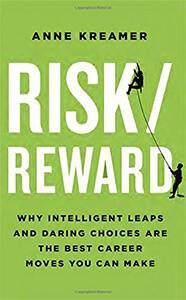6 Tips to Declare Your Work Independence
Advice from 'Risk/Reward' to let you break free through smart career moves
On July 4, our nation will once again celebrate the Declaration of Independence. This year, why not honor the holiday in a more meaningful, personal way and use it as motivation to declare your work independence?
Whether you’re looking to change jobs, switch careers or start your own business, there is inspiration to be gained from the courage of our founding fathers and gain control of your career destiny. Of course, saying you should embrace change and actually doing it are two different things. Change involves risk and our human nature is to avoid risk.
An excellent new book, Risk/Reward: Why Intelligent Leaps and Daring Choices are the Best Career Moves You Can Make, by journalist and author Anne Kreamer could help you make your next professional move.

What's Your Risk-Taking Profile?
Based on proprietary research from national studies, Kreamer divides people into four risk-taking profiles: Pioneers, Thinkers, Defenders and Drifters. (Her book and website, Annekreamer.com, have quizzes to help you determine your type; the book's quiz identified me as a Thinker primarily and a Pioneer secondarily and I nodded my head in recognition.) Then she explains the strengths and pitfalls of each, as well as targeted strategies to help integrate smart risk-taking into your worklife. Throughout the book are engaging interviews with notables such as Jane Pauley and CNBC’s Jim Cramer on their personal risk taking.
For such a serious topic, this book is a surprisingly enjoyable and entertaining read. I recommend you add it to your summer reading list. But in the meantime, here are six tips from it to help you strengthen your risk-taking muscles:
1. Listen to your inner voice. It’s essential to become acutely aware what you do — or would like to do — providing more than just the satisfaction of a paycheck, says Kreamer. That way you can align the risks you take with your truest self and find the resolve to make needed changes. “Each of us has a unique and deep-seated combination of beliefs, needs, desires, and sensibility — not necessarily wholly conscious, but nonetheless a vision — that guides our life,” she writes.
2. Embrace small risks. Learning risk-taking is a bit like building muscles at the gym. It’s far more effective to start out lifting small weights consistently, than risk injury lifting heavy weights too soon. In your career, practice taking modest, measured risk-taking, such as speaking up in a meeting or asking someone new to lunch, before you attempt high-stake goals like quitting your job. Small actions build up to larger ones, and over time you’ll reduce your fear and gain greater confidence in your skills.
3. Do something different. Most of us need practice inviting the new into our lives. It’s a mental muscle that takes time to develop. So make it a habit to do something a bit out of the ordinary on a regular basis: Ask someone you don’t know well at work a specific question about his or her job, for example. Outside the office, tap into free local programs at the library or at colleges that can help you explore a new career path. The more comfortable you become trying new things, the more likely you’ll be to seek out opportunities outside your comfort zone.
4. Expand your circle of contacts. Start including people outside your usual spheres of influence who can provide advice and resources. Frequently, those who aren’t work colleagues have the distance to suggest new roles and different applications of your skills.
5. Think long term. “The new world of work is seldom a matter of committing to just one narrowly defined goal, but rather a series of goals, a lifelong decathlon of your own design,” writes Kreamer. So don’t just pick your next job because it offers a decent salary or a speedy commute. Look for one that will offer opportunities to learn new skills, broaden your perspective and expand your networks in a way that complements your long-term goals.
6. Get comfortable with being uncomfortable. Nobody likes feeling anxious. But as Kreamer points out: “Anxiety, although scary, is a natural result of contemplating change, like sore muscles after a workout.” By integrating the habits outlined in the book, you’ll be less fearful of declaring your work independence as you strive to achieve a better life plus “liberty and the pursuit of happiness.”


